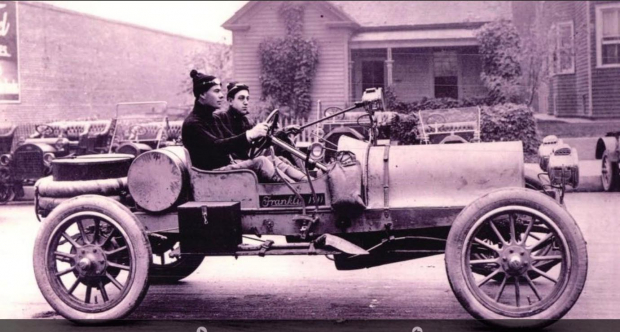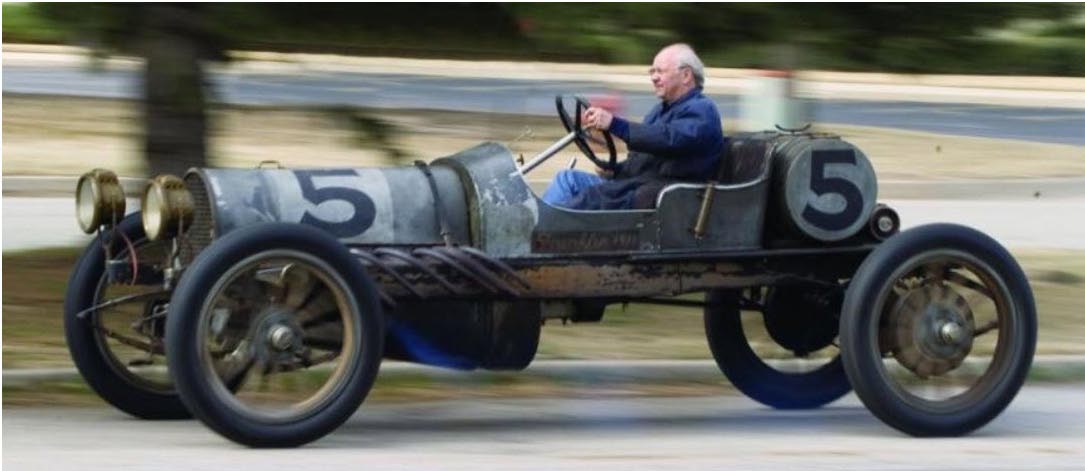Hemmings Blog (2010) “Sand Special Riding: Ralph Hamlin’s 1911 Franklin Special desert racer”

Max Axen has forwarded this 2010 Hemmings article by David Traver Adolphus on one of the "few survivors of the Guided Age"-Ralph Hamlin's 1911 Franklin Special desert racer.
Enjoy,
Howard Kroplick
Sand Special
Riding Ralph Hamlin's 1911 Franklin Special desert racer
from Hemmings Classic Car
December, 2010 - Words and Photography by David Traver Adolphus
There are few survivors from the Gilded Age of racing, and each one stands apart from all other period cars, no matter what they are. The Marmon Wasp, Great Race Thomas Flyer, "Old 16" Locomobile, Alco Black Beast, Corbin Cannonball, Packard Grey Wolf: each is inseparable from the stories of the men who drove them and the almost inconceivable risks and trials they endured.
Outnumbered in the Oughts and early Teens by European competitors, they were the sharp end of the American auto industry, competing with established makes like Mercedes, Fiat, Delage and Peugeot in order to prove that we could take on the best from Europe, and win.
Few cars from that handful of survivors have endured without either controversy or restoration. None of them have been forgotten, exactly, but some are better remembered than others. The ones we know well are mostly East Coast machines, or Indianapolis 500 entrants; West Coast veterans are rarer, even ones that ran in "the toughest road race ever held anywhere," the Los Angeles to Phoenix desert race.
Los Angeles was home to renowned Southern California Franklin distributor Ralph Hamlin who, from 1905 through the company's post-Depression bankruptcy, did more than any other individual to promote the brand. "It was not easy to sell air cooling," he wrote in Five Years on the Desert. "My competitors, all of whom sold water-cooled cars, would tell my prospects that if air cooling was so good, the rest of the cars would be using it." So as promoters had been, if not since time immemorial, then at least for a few years, he decided to race the car to prove it. "I entered any event that came along. When the desert race was suggested, it was my chance to put air cooling on top, if I could win."
Hamlin started his campaign in a Model H Franklin "Greyhound" at the inaugural 1908 race.He jumped out in front, building a lead of several hours while still in California, but got lost in the desert due to the fact that the race started at midnight. Worried about getting truly turned around, he grabbed four hours of sleep until daybreak, and ended up in fourth, three-and-a-half hours behind Black Bess, the winning White Steamer. He brought another Model H to the 1909 race, but this time crushed the differential against a railroad cross-tie at speed.
"This was an engine that could take anything we tried to give it in the line of punishment," Hamlin was quoted as saying, and he added more punishment to the roster when he returned for the "Sand Party" in 1910 with a brand-new 1911 model year car. Franklins of the era featured a Renault-style sloping hood, but for high-speed running, they fitted it with Hamlin's preferred older-style barrel hood. Over the years, there has been some confusion about exactly what car he used in 1910 and 1911: In his memoirs, Hamlin states the 1910 car was another Model H, but it used a Model D, 301.5-cu.in. engine on the H chassis--they produced the same horsepower, but the D was lighter. Photos from the race clearly show our feature car, right down to the bend of the exhausts and the "Franklin 1911" script on the plaques. Additionally, photos of the 1912 model year car he ran in 1911 show the Renault-style hood, although The Automobile stated he "used the same machine," probably confused by the Model D engine he ran in 1910.
The six-cylinder Special speedster made 38hp from its auxiliary-valve, air-cooled engine, which was apparently a surprise to Hamlin, who had thought a four-cylinder car was on its way from the factory. What arrived was "rigged for fast work, with a speedometer, Prest-o-Lite tank, and with a hood on the front to keep sand from blowing onto the handsome 1911 engine," said The Los Angeles Times on October 18, 1910. "The car is one of the nobbiest Franklin roadsters that has ever been sent out for a race and Hamlin is satisfied..."
"The route was across the desert," he told the Times in 1928. "The road was pretty fair until we got a little ways beyond Pasadena, and then the struggle started.
"The water-cooled boys went out several days before the race to plant barrels of water for use when their motors started to boil in the more than 100 degrees of temperature. All of us wore baseball masks to keep the mesquite and buckthorn bushes from scratching our eyes out. Tires were deflated to half pressure so the wheels would not sink in the sand. Springs were tied down with iron straps to keep them from breaking," an improvement over the friction tape and fishing line method Hamlin had used in 1908.
This time he made some headway in the race, coming in second to Harvey Herrick's Kisselkar with a nonstop 16 hour, 16 minute, 30 second time for the 418-mile Sand Battle: "I was outdriven, that's all there is to it," he said. "My car is right, but I would not take the road at the clip the Kissel rolled over the rough. I'm satisfied and want to congratulate the man who drove that car." Thousands thronged the last miles of the course, some having followed the race all the way from California aboard the Howdy Special chase train, with the Howdy Band playing the official race song, "Hot Time in the Old Town Tonight."
The car was right in 1910, and it's still right today. The Times called it "one of the snappiest engines ever turned out by the Syracuse factory," accurate in more than one sense, as it's the most pummeling, staccato engine noises we've ever heard. The exhaust pulses are distinct and, thanks to the Franklin exhaust valve at the bottom of the cylinder, slightly irregular. Just at idle, it's akin to having someone toss lit firecrackers at your head--snap, snap, snapsnap, snap. You can feel the air compressing as exhaust explodes from the six little and two big, wicked open pipes, pummeling you back a step. And that's at idle. When Oklahoma City's Ted Davis takes it out for a spin, there's no way anyone would ever think "car," because "low flying warplane" is what comes to mind. It's a wall of pure power.
The 1911 Franklin Special's history after the 1910 Cactus Derby is surprisingly simple: In 1913, Hamlin sold it to Howard Bonebrake of El Reno, Oklahoma, who wanted a race car. Bonebrake drove it an unknown number of times in the Teens, and also accumulated an extensive file of correspondence with the Franklin factory, over 200 letters now in Ted Davis's possession, firmly establishing both its provenance and Model D engine.
Bonebrake obviously didn't use it extensively, though, because the condition is little different now than in 1910.
He eventually stored it upstairs at his Bonebrake Hardware and Implement Company, which is where Don Boulton (HCC #65) found it in 1960, selling it 40-some years later to his friend and fellow collector Ted.
Today, the Special is on loan to the new Franklin museum at Hickory Corners, Michigan, where Ted Davis was a sensation at the grand opening, giving children rides around the grounds. "We had a grand time," he said. A century later, this unrestored desert racer is fulfilling exactly the same purpose it did in 1910: promoting the cars to which Ralph Hamlin dedicated his life. If he were somehow still with us, it's just what he'd want.


Comments
This car was included in a Jay Leno segment in 2012, when it won its class at Pebble Beach.
https://www.youtube.com/watch?v=5f_vUbzh5l8
_______________________________________________
From Howard Kroplick:
Thanks, I have added the YouTube above.